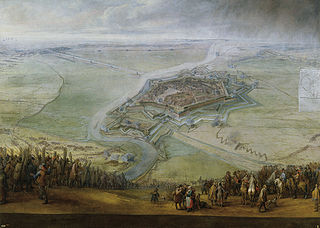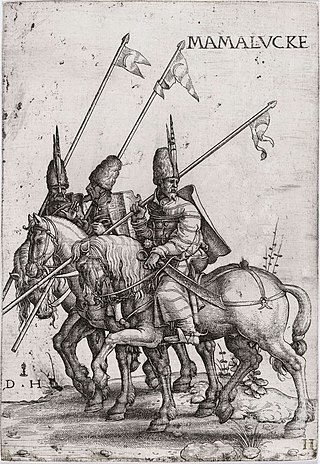Related Research Articles

The 16th century begins with the Julian year 1501 (MDI) and ends with either the Julian or the Gregorian year 1600 (MDC).

1624 (MDCXXIV) was a leap year starting on Monday of the Gregorian calendar and a leap year starting on Thursday of the Julian calendar, the 1624th year of the Common Era (CE) and Anno Domini (AD) designations, the 624th year of the 2nd millennium, the 24th year of the 17th century, and the 5th year of the 1620s decade. As of the start of 1624, the Gregorian calendar was 10 days ahead of the Julian calendar, which remained in localized use until 1923.

1598 (MDXCVIII) was a common year starting on Thursday of the Gregorian calendar and a common year starting on Sunday of the Julian calendar, the 1598th year of the Common Era (CE) and Anno Domini (AD) designations, the 598th year of the 2nd millennium, the 98th year of the 16th century, and the 9th year of the 1590s decade. As of the start of 1598, the Gregorian calendar was 10 days ahead of the Julian calendar, which remained in localized use until 1923.

Year 1543 (MDXLIII) was a common year starting on Monday of the Julian calendar. It is one of the years sometimes referred to as an "Annus mirabilis" because of its significant publications in science, considered the start of the scientific revolution.

1593 (MDXCIII) was a common year starting on Friday of the Gregorian calendar and a common year starting on Monday of the Julian calendar, the 1593rd year of the Common Era (CE) and Anno Domini (AD) designations, the 593rd year of the 2nd millennium, the 93rd year of the 16th century, and the 4th year of the 1590s decade. As of the start of 1593, the Gregorian calendar was 10 days ahead of the Julian calendar, which remained in localized use until 1923.

1605 (MDCV) was a common year starting on Saturday of the Gregorian calendar and a common year starting on Tuesday of the Julian calendar, the 1605th year of the Common Era (CE) and Anno Domini (AD) designations, the 605th year of the 2nd millennium, the 5th year of the 17th century, and the 6th year of the 1600s decade. As of the start of 1605, the Gregorian calendar was 10 days ahead of the Julian calendar, which remained in localized use until 1923.

1614 (MDCXIV) was a common year starting on Wednesday of the Gregorian calendar and a common year starting on Saturday of the Julian calendar, the 1614th year of the Common Era (CE) and Anno Domini (AD) designations, the 614th year of the 2nd millennium, the 14th year of the 17th century, and the 5th year of the 1610s decade. As of the start of 1614, the Gregorian calendar was 10 days ahead of the Julian calendar, which remained in localized use until 1923.

Year 1560 (MDLX) was a leap year starting on Monday of the Julian calendar.

1592 (MDXCII) was a leap year starting on Wednesday of the Gregorian calendar and a leap year starting on Saturday of the Julian calendar, the 1592nd year of the Common Era (CE) and Anno Domini (AD) designations, the 592nd year of the 2nd millennium, the 92nd year of the 16th century, and the 3rd year of the 1590s decade. As of the start of 1592, the Gregorian calendar was 10 days ahead of the Julian calendar, which remained in localized use until 1923.

The 1550s decade ran from January 1, 1550, to December 31, 1559.
The 1590s decade ran from January 1, 1590, to December 31, 1599.

Year 1558 (MDLVIII) was a common year starting on Saturday of the Julian calendar.

Year 1552 (MDLII) was a leap year starting on Friday of the Julian calendar.

Year 1545 (MDXLV) was a common year starting on Thursday of the Julian calendar.

Year 1516 (MDXVI) was a leap year starting on Tuesday of the Julian calendar.
Al-Maqrīzī or Maḳrīzī, whose full name was Taqī al-Dīn Abū al-'Abbās Aḥmad ibn 'Alī ibn 'Abd al-Qādir ibn Muḥammad al-Maqrīzī (1364–1442) was a medieval Egyptian historian and biographer during the Mamluk era, known for his interest in the Fatimid dynasty and its role in Egyptian history.

Abu Abdullah Muhammad al-Idrisi al-Qurtubi al-Hasani as-Sabti, or simply al-Idrisi, was a Muslim geographer, cartographer and Egyptologist who for some time lived in Palermo, Sicily at the court of King Roger II. Muhammed al-Idrisi was born in Ceuta then belonging to the Almoravids. He created the Tabula Rogeriana, one of the most advanced medieval world maps.
The year 1811 in science and technology involved some significant events, listed below.
The year 1582 in science and technology included a number of events, some of which are listed here. This year sees the introduction of the Gregorian calendar, promulgated by Pope Gregory XIII in the Papal bull Inter gravissimas on February 24 and based largely on the work of Christopher Clavius. Under the Habsburg monarchy in Spain, Portugal and Italy, together with the Polish–Lithuanian Commonwealth, the year continues under the Julian calendar as normal until Thursday October 4, the next day becoming Friday October 15; France follows two months later, letting Sunday December 9 be followed by Monday December 20. Other countries switch in later years.
Urbain Hémard was a French physician and dentist. He wrote the first French work entirely devoted to dentistry.
References
- ↑ "Thermometer". Encyclopedia Britannica. Retrieved 3 April 2018.
- ↑ Lançon, Pierre (2012). "Du bistouri à l'action politique : le destin mouvementé du chirurgien ruthénois Urbain Hémard (vers 1548-1592)" (PDF). Actes de la Société française d'histoire de l'art dentaire (in French). 17: 17–23. Retrieved 4 March 2021.